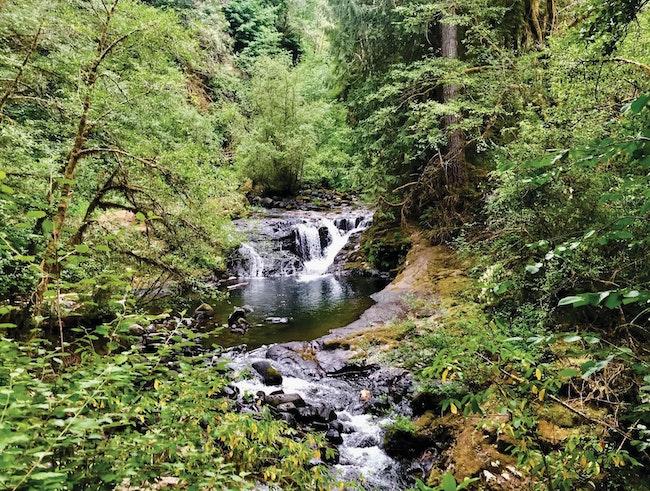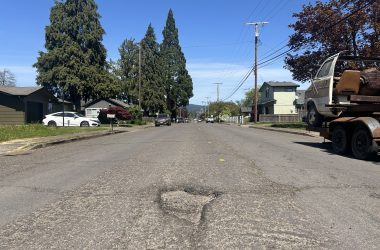 FRANK ARMENDARIZ/PHOTO This small stream is a short drive from the southern Willamette Valley. On many late spring days it offers reasonable solitude and exists on public lands in the Siuslaw National Forest.
FRANK ARMENDARIZ/PHOTO This small stream is a short drive from the southern Willamette Valley. On many late spring days it offers reasonable solitude and exists on public lands in the Siuslaw National Forest.
THE ANGLER’S LOG
It’s been an early fishing and outdoors recreation season that has tested the patience of anglers infected with a bad case of cabin fever and has kept fishing reporters guessing as to where to direct their readers and listeners for the best angling experience. Last spring I had fished more than twenty days by mid-June, on the dune lakes in far west Lane County for bass and on my home river, the McKenzie, for trout and had plenty of information to share.
This season I’ve been out less than half-a-dozen days fishing on the lakes and I am still trying to align conditions and availability for a McKenzie fishing trip for any available species. In fact, earlier this week I had to cancel a day of spring salmon fishing when the McKenzie and Middle Fork Willamette “blew out” because of last weekend’s rainstorm.
It was good news when Willamette Valley reservoirs filled in late May, it ensured that the fishing and boating season would last through the summer. But now with no storage capacity remaining, the amount of water discharged from our reservoirs is equal to the amounts draining the mountainous terrain above each dam, causing river levels to fluctuate wildly, making conditions difficult to predict and hard to plan for. Salmon don’t necessarily appreciate the wild fluctuations either. It stalls their migration into the southern valley. Rather than push against all that current, the fish hunker down to conserve energy. On days with good river levels the fishing has generally been good in our local rivers and although the run has been in stop-and-go mode for most of spring, close to 14,000 spring chinook salmon have made their way into the rivers of the southern Willamette Valley. And trout stocking has gone on without a hitch and on schedule to all the local lakes and rivers.
With full reservoirs those able to fish the lakes have had some very good fishing for trout and Kokanee. But the recent weather, far more reminiscent of March than June, has made lake fishing a bit unpredictable too. Favoring boaters whose craft are equipped with a bimini and side skirts or a cuddy-style cabin to escape the rain and bluster that has characterized most of May and now early June. For folks in open boats or fishing from the bank … it’s been a test of endurance, will and the quality of your rain gear.
There is a “silver lining,” about the time my report reaches you things might actually begin to dry out and by the weekend our local rivers will fall to reasonable levels for boating and fishing. Last season at this exact time we were looking at a water shortage crisis and large parts of eastern Oregon are still experiencing extreme drought conditions. Here in western Oregon, particularly the northwest corner of our state, that is no longer the case. Very good news for this summer’s fishing is that there is an abundance of water, as much as 125% of average. Should make for wonderful angling conditions far into the fall; at least for this year.
The abundance of water also opens up other fishing opportunities that often diminish by the beginning of summer each year. One of my favorites is “small stream” fishing and there are dozens of them all over Lane County, likely thousands across the state. In most instances small streams are going to hold native species of trout, both rainbows and cutthroats. Although there are a few that are seeded with hatchery fish at the beginning of each trout season, in our vicinity, Fall Creek, a tributary of the Willamette River, has hatchery trout planted directly into the creek. On Blue River, a tributary of the McKenzie, you are allowed to harvest two wild trout per day and although trout are not planted directly into Blue River but into Blue River Reservoir, a number of them find their way into the creek where the limit is five per day.
Maybe the best part about seeking out small streams is the fact that many are on public lands managed by the Forest Service or Bureau of Land Management and your right to access these lands is relatively limitless. This would exclude designated wilderness areas where you will likely encounter permit application, day use, or other type of user fee. But for the most part of both the Willamette National Forest to the east and the Siuslaw National Forest to the west, you will find plenty of water to explore.
The best approach is to wade, my favorite small stream is only accessible from the road at a couple of locations. But once I’m on the stream bed, I’ve been able to wade up and down the stream for about a half-mile. Which is about as far from my vehicle as I generally care to hike. I almost always “wet wade” but don footwear designed for increased traction and I always use a wading staff. Consider that you could be miles from help and even a mild sprain or other “slipping injury” could easily turn a great day of fishing in relative isolation to one with a different set of memories.
A lot of tackle, baits and lures work in small stream conditions but you do want to think small. On occasion you will hook a nice 12-14 inch trout, a trophy given the petite nature of these streams. But most of what you will encounter will fall into the 6- to 10-inch class range. Also, scaled down tackle is a lot easier to manage in brushy habitats. My rod of choice for small streams is a 5-weight, 7.5-foot fiberglass fly rod with a weight forward floating line and a 4.5-foot tapered leader. Fiberglass rods load quickly because of the innate flexibility of fiberglass and that allows you to make short but very accurate casts. A lot of different flies will work, I always have more caddis imitations in my fly box but humpy, Adams and royal coachman dry and others are all effective.
Radio: KDUN, 1030AM








